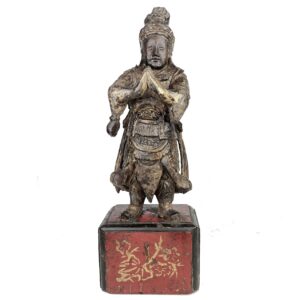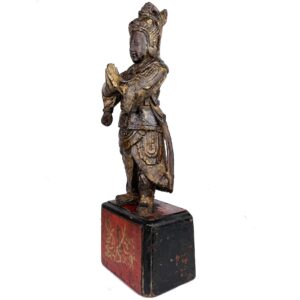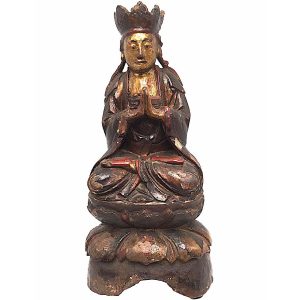-
Sale!


$695.00 Original price was: $695.00.$395.00Current price is: $395.00.
H: 16.25: W: 5.875” D: 3.5” | FOR SHIPPING INFORMATION CONTACT US AT 213-568-3030
Attendant Chou Ts’ang, to Guandi, most revered Chinese military hero and Taoist God of War, hands clasped and eyes down in respect wearing detailed military clothing and boots on high pedestal with painted gold florals.
-
Sale!


$475.00 Original price was: $475.00.$295.00Current price is: $295.00.
H: 11.6 ” W: 5.3 ” D: 4.25 ” | FREE SHIPPING WITHIN CONTINENTAL U.S.
This provincial Guanyin made for a home altar sits in anjali mudra. Portrayed as humble, approachable, she wears a 5-lobed diadem, hair in a chignon with braids and modest robe seated on a waisted lotus throne with stacked lotuses.
-
Sale!


$450.00 Original price was: $450.00.$325.00Current price is: $325.00.
H: 11.75″ W: 5.25″ D: 4.75 ” | Free shipping within continental us
This provincial Nanhai Guanyin sits with her palms at her heart in anjali mudra, a mudra of offering rarely used for Nanhai Guanyin. She sits on a two tiered lotus throne on a lotus at the entrance to her Tidal Cave on Putuo under a craggy rock outcrop framed by pierced openwork. Placed on a home altar, her modest presentation reflect local beliefs to resonate with provincial populations.
-


$7,300.00
H: 28.25 W: 12.75” D: 9.75” | CALL 213-568-3030 OR EMAIL [email protected] FOR SHIPPING COST
Although they are Buddhist images, Lohans are portrayed as a real person with very individual, distinctive, and un-idealized features. His benevolent youthful sweetly smiling face with downcast eyes is an image of compassion, wisdom and peace.This exceptional, beautifully crafted rare 17-18th century Ming/Qing large Lohan is from the same Buddhist location as the foreign-born heavy bearded Lohan Bodhidharma, and the same artist may have carved both. We recommend keeping them as a pair to display together.
End of content
End of content








